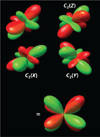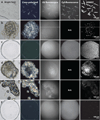Second-order nonlinear optical imaging of chiral crystals
- PMID: 21469954
- PMCID: PMC3345893
- DOI: 10.1146/annurev.anchem.111808.073722
Second-order nonlinear optical imaging of chiral crystals
Abstract
Second-order nonlinear optical imaging of chiral crystals (SONICC) is an emerging technique for crystal imaging and characterization. We provide a brief overview of the origin of second harmonic generation signals in SONICC and discuss recent studies using SONICC for biological applications. Given that they provide near-complete suppression of any background, SONICC images can be used to determine the presence or absence of protein crystals through both manual inspection and automated analysis. Because SONICC creates high-resolution images, nucleation and growth kinetics can also be observed. SONICC can detect metastable, homochiral crystalline forms of amino acids crystallizing from racemic solutions, which confirms Ostwald's rule of stages for crystal growth. SONICC's selectivity, based on order, and sensitivity, based on background suppression, make it a promising technique for numerous fields concerned with chiral crystal formation.
Figures










Similar articles
-
Direct observation of transient Ostwald crystallization ordering from racemic serine solutions.J Am Chem Soc. 2010 Oct 6;132(39):13598-9. doi: 10.1021/ja106728c. J Am Chem Soc. 2010. PMID: 20828149
-
Selective detection and quantitation of organic molecule crystallization by second harmonic generation microscopy.Anal Chem. 2010 Jul 1;82(13):5425-32. doi: 10.1021/ac100564f. Anal Chem. 2010. PMID: 20515064
-
Kinetic trapping of metastable amino acid polymorphs.J Am Chem Soc. 2014 Feb 12;136(6):2404-12. doi: 10.1021/ja410293p. Epub 2014 Feb 4. J Am Chem Soc. 2014. PMID: 24451055 Free PMC article.
-
Screening of protein crystallization trials by second order nonlinear optical imaging of chiral crystals (SONICC).Methods. 2011 Dec;55(4):379-86. doi: 10.1016/j.ymeth.2011.11.003. Epub 2011 Nov 17. Methods. 2011. PMID: 22101350 Free PMC article. Review.
-
Applications of ultrasound to chiral crystallization, resolution and deracemization.Ultrason Sonochem. 2018 May;43:184-192. doi: 10.1016/j.ultsonch.2018.01.014. Epub 2018 Jan 11. Ultrason Sonochem. 2018. PMID: 29555274 Review.
Cited by
-
Structure Determination of Membrane Proteins Using X-Ray Crystallography.Methods Mol Biol. 2021;2302:101-136. doi: 10.1007/978-1-0716-1394-8_7. Methods Mol Biol. 2021. PMID: 33877625 Free PMC article.
-
Water-solid interactions in amorphous maltodextrin-crystalline sucrose binary mixtures.Pharm Dev Technol. 2014 Mar;19(2):247-56. doi: 10.3109/10837450.2013.775157. Epub 2013 Mar 12. Pharm Dev Technol. 2014. PMID: 23477494 Free PMC article.
-
The Interaction of 2D Materials With Circularly Polarized Light.Adv Sci (Weinh). 2023 Apr;10(10):e2206191. doi: 10.1002/advs.202206191. Epub 2023 Jan 25. Adv Sci (Weinh). 2023. PMID: 36698292 Free PMC article. Review.
-
High frame-rate multichannel beam-scanning microscopy based on Lissajous trajectories.Opt Express. 2014 Oct 6;22(20):24224-34. doi: 10.1364/OE.22.024224. Opt Express. 2014. PMID: 25321997 Free PMC article.
-
Serial femtosecond X-ray diffraction of enveloped virus microcrystals.Struct Dyn. 2015 Aug 20;2(4):041720. doi: 10.1063/1.4929410. eCollection 2015 Jul. Struct Dyn. 2015. PMID: 26798819 Free PMC article.
References
-
- Stehlin T, Feller M, Guyot-Sionnest P, Shen YR. Optical second-harmonic generation as a surface probe for noncentrosymmetric media. Opt. Lett. 1988;13:389. - PubMed
-
- Shen YR. Surface properties probed by second-harmonic and sum-frequency generation. Nature. 1989;337:519–525.
-
- Eisenthal KB. Equilibrium and dynamic processes at interfaces by second harmonic and sum frequency generation. Annu. Rev. Phys. Chem. 1992;43:627–661.
-
- Boyd RW. Nonlinear Optics. 2nd ed. Amsterdam: Academic; 2003.
-
- Shen YR. The Principles of Nonlinear Optics. New York: Wiley; 1984.
Publication types
MeSH terms
Substances
Grants and funding
LinkOut - more resources
Full Text Sources
Other Literature Sources

